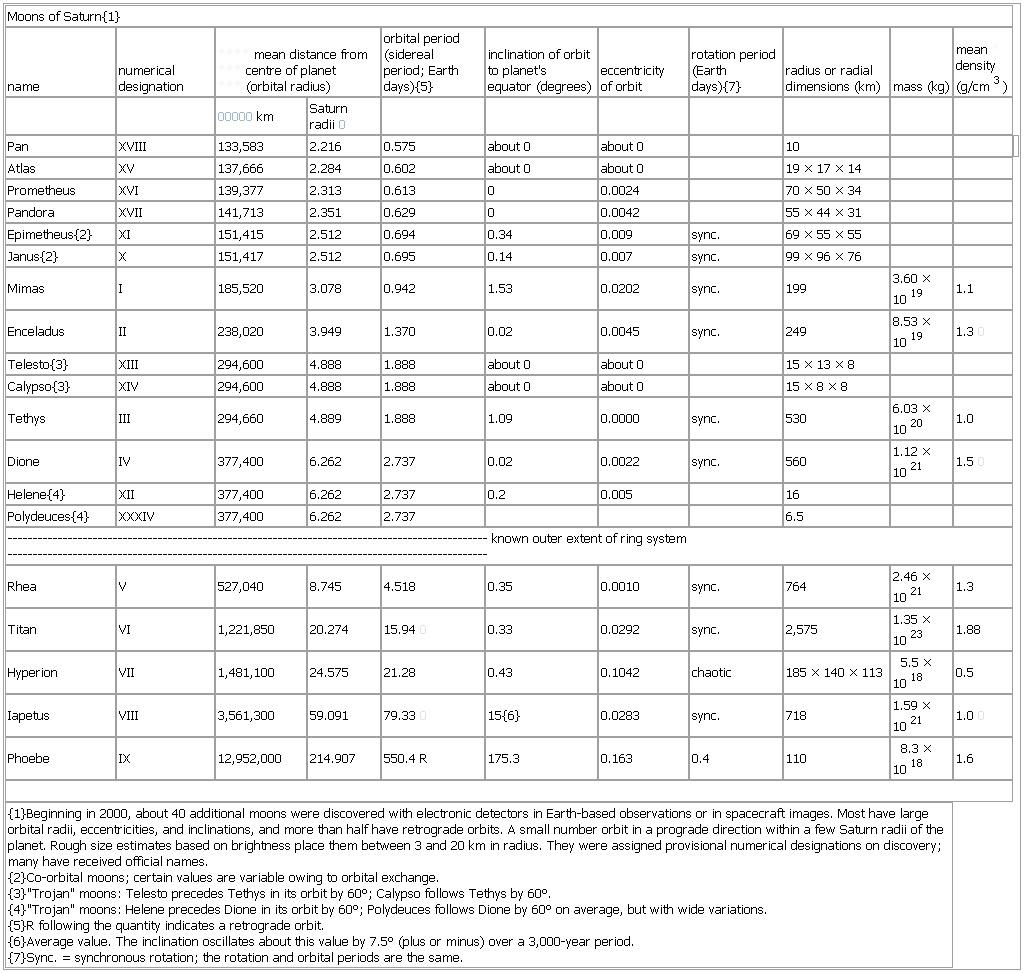- Moons of Saturn
-
▪ TableMoons of Saturn{1}name numerical designation ****mean distance from***centre of planet***(orbital radius) orbital period (sidereal period; Earth days){5} inclination of orbit to planet's equator (degrees) eccentricityof orbit rotation period (Earth days){7} radius or radial dimensions (km) mass (kg) mean* density (g/cm3)00000km Saturnradii0Pan XVIII 133,583 2.216 0.575 about 0 about 0 10Atlas XV 137,666 2.284 0.602 about 0 about 0 19 × 17 × 14Prometheus XVI 139,377 2.313 0.613 0 0.0024 70 × 50 × 34Pandora XVII 141,713 2.351 0.629 0 0.0042 55 × 44 × 31Epimetheus{2} XI 151,415 2.512 0.694 0.34 0.009 sync. 69 × 55 × 55Janus{2} X 151,417 2.512 0.695 0.14 0.007 sync. 99 × 96 × 76Telesto{3} XIII 294,600 4.888 1.888 about 0 about 0 15 × 13 × 8Calypso{3} XIV 294,600 4.888 1.888 about 0 about 0 15 × 8 × 8Helene{4} XII 377,400 6.262 2.737 0.2 0.005 16Polydeuces{4} XXXIV 377,400 6.262 2.737 6.5———————————————————————————————————————————————— known outer extent of ring system ————————————————————————————————————————————————{1}Beginning in 2000, about 40 additional moons were discovered with electronic detectors in Earth-based observations or in spacecraft images. Most have large orbital radii, eccentricities, and inclinations, and more than half have retrograde orbits. A small number orbit in a prograde direction within a few Saturn radii of the planet. Rough size estimates based on brightness place them between 3 and 20 km in radius. They were assigned provisional numerical designations on discovery; many have received official names.{2}Co-orbital moons; certain values are variable owing to orbital exchange.{3}"Trojan" moons: Telesto precedes Tethys in its orbit by 60°; Calypso follows Tethys by 60°.{4}"Trojan" moons: Helene precedes Dione in its orbit by 60°; Polydeuces follows Dione by 60° on average, but with wide variations.{5}R following the quantity indicates a retrograde orbit.{6}Average value. The inclination oscillates about this value by 7.5° (plus or minus) over a 3,000-year period.{7}Sync. = synchronous rotation; the rotation and orbital periods are the same.See as table:

* * *
Universalium. 2010.
